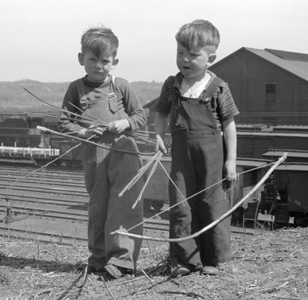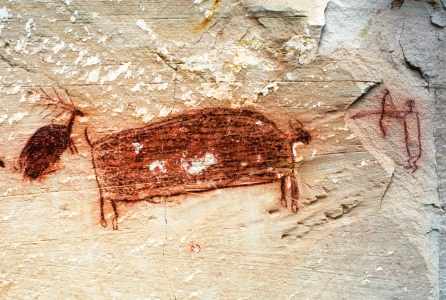As I reflect back on last year’s hunting season, I have merely to close my eyes and I can see the big buck walk out of the trees following a doe. I had seen him several times on my trail cameras, but this was the first time I saw him on the hoof.
He was more impressive at 225 yards than he was on the camera photos. His heavy rack glistened in the early morning light, and his large frame and musculature rippled with his every move. Within minutes, he was joined by five other bucks, all looking to attract the attention of the doe. But that was not to be. The big buck had already established his dominance, and the other bucks gave his superior size and long, heavy tines plenty of room.
At first it didn’t occur to me that I might actually be able to harvest this magnificent creature with my bow. I would have been happy just to have witnessed the early morning rut behavior.
I watched the six bucks and single doe for several minutes. The big buck was intent on keeping the doe close by. The smaller bucks sparred among themselves, keeping a watchful eye on the doe in hopes the big buck would wander too far away.
Over the next half hour, the doe and big buck wandered through food plots and native grass plantings, hopped from one trail to another, and eventually walked within 17 yards of my stand, giving me the opportunity for a successful and lethal shot. The excitement, however, didn’t end there. Over the next 25 minutes, four of the other bucks walked past my stand — each within 15 yards or closer.
The shot took only a couple of seconds. The experience lasted an hour — much longer if you count the two and half hours it took to track the big buck down (mostly on my hands and knees). The euphoria will last a life time.
What We Call "Progress"
That day in my stand, I was using a compound bow with sights, stabilizer, noise suppressor, graphite arrows, expanding broadheads, and a mechanical release. I was sitting in an elevated stand with a built-in padded seat and a bow holder on each side of the tree. Around my neck were a pair of 10-power binoculars and a range finder. I was wearing clothes that would allow me to hunt in every unfavorable weather condition known to man — every piece of which was sprayed with a scent eliminator.
 When I started bow hunting almost 50 years ago, I had a recurve bow and cedar arrows with fixed broadheads, and I shot instinctively using my fingers to pull back the string. My friend was more sophisticated: he had a sight that consisted of a wooden matchstick taped to the riser of his bow. My stands were the crotch of a tree or a homemade contraption that took more stupidity than strength to attach to a tree and stand in. Hunting clothes were the same coveralls I used to change oil in the car, and my extra hunting paraphernalia consisted of whatever I could get in my pockets without displacing a peanut butter sandwich.
When I started bow hunting almost 50 years ago, I had a recurve bow and cedar arrows with fixed broadheads, and I shot instinctively using my fingers to pull back the string. My friend was more sophisticated: he had a sight that consisted of a wooden matchstick taped to the riser of his bow. My stands were the crotch of a tree or a homemade contraption that took more stupidity than strength to attach to a tree and stand in. Hunting clothes were the same coveralls I used to change oil in the car, and my extra hunting paraphernalia consisted of whatever I could get in my pockets without displacing a peanut butter sandwich.
In 50 years, technology has changed our level of comfort in the field, our ability to access remote areas and see over greater distances, and — most dramatically — our ability to harvest game over great distances. I recently watched an outdoor hunting program in which the narrator remarked that he had just made his first successful 1,400-yard shot. My first thought was: how many unsuccessful shots had he made? I don’t recall what the target was, but it was clear that the narrator was not in admiration of the harvested game but rather the equipment and technology that allowed him to make the shot.
I watched a video of young boy, hardly 7 years old, shoot an elk at 500 yards. His part was no doubt limited to pulling the trigger after an adult made the necessary sight adjustments and locked the gun into position. I couldn’t help but think the young lad was being deprived of the opportunity to observe the elk in its natural habitat doing its natural things and to experience the thrill of the stealth needed to enter that habitat without the elk knowing it.
Changing the Chase
 Hunting has changed a lot since our forefathers walked into the woods with black powder rifles and iron sights. Today, we have rifles that can shoot unheard of distances, scopes with built-in range finders that adjust for myriad external factors, and bullets that are manufactured to extreme tolerances that allow consistent shooting patterns. And anyone can download bullet calculators and punch in the zero range, caliber, bullet type, and weight. You can even factor in different temperatures and wind speeds. You can print out the exact bullet drop out to several hundred yards.
Hunting has changed a lot since our forefathers walked into the woods with black powder rifles and iron sights. Today, we have rifles that can shoot unheard of distances, scopes with built-in range finders that adjust for myriad external factors, and bullets that are manufactured to extreme tolerances that allow consistent shooting patterns. And anyone can download bullet calculators and punch in the zero range, caliber, bullet type, and weight. You can even factor in different temperatures and wind speeds. You can print out the exact bullet drop out to several hundred yards.
My weapon of choice has been and always will be a bow. I can call it primitive, but the truth is even bows have become finally tuned instruments. It is no longer a stick and string that requires hours of practice and the ability for the user to get within a few yards of his or her prey. Sights, mechanical releases, engineering designs, machining techniques, and numerous technological advances now allow an otherwise average shooter to significantly increase their effective range two, three, or more times. I am no different. My current bow, with all its technological advances, cost me well over a thousand dollars. Although I chose the bow design to improve my shooting skill and reduce the potential for wounding the game I was pursuing, I also knew it would allow me to shoot greater distances. And there-in lies the problem: At what level do we allow technology to substitute for stealth, cunning, planning, practice, studying and learning the habits and characteristics of the game we are after, and the general ability to get into the game’s habitat? At what point do we fear sacrificing the respect we have for the game and instead shift our respect to the equipment and technology that goes into that equipment? And ultimately, when does the goal become the shot and the game simply a target?
Can We Keep Ethics in the Equation?
We live in a society that thrives on technological advances. We are surrounded by devices that allow us to be in constant communication, to have tools at our fingertips to make our life easier. So it’s not surprising that those innovations have spread to outdoor activities: hunting, fishing, bird watching, trapping, and more.
Technology itself is not a bad thing — it’s how we use it and allow it to dictate our life’s behaviors that become the problem. I have a friend who is adamantly opposed to the use of robotic ducks, those battery powered decoys that have wings that rotate and simulate a hovering duck. My friend would argue that they are so effective in attracting ducks that they increase the number of birds killed. I have another friend who will argue that robo-ducks bring ducks closer and thus reduce wounding. They are both right, and I know they both have the greatest respect for the waterfowl they pursue and neither will ever think more of the mechanical duck than the wild creatures they are hunting.
 Drones may be the next technological innovation that challenges our moral attitudes with regard to fair chase hunting. Drones are not new and have been used successfully by the military for years. As a tool for the civilian sector, drones have the ability to provide valuable and timesaving information relating to all sorts of needs. As a game management tool, drones can be sent into isolated areas and assess game conditions and populations with little, if any, disturbance when used properly. Drones continue to be improved, to become more powerful and more easily controlled, to be capable of countless functions we haven’t even thought of yet, and more available to the public. So should we be concerned that some people will be using drones to not only locate game but to push game to areas that are more accessible for them to hunt? Yes, there are laws that restrict the use of unmanned aircraft in the pursuit of game, but the gray area between anyone’s use of free airspace and what may actually be a deliberate attempt to take game is a very wide area.
Drones may be the next technological innovation that challenges our moral attitudes with regard to fair chase hunting. Drones are not new and have been used successfully by the military for years. As a tool for the civilian sector, drones have the ability to provide valuable and timesaving information relating to all sorts of needs. As a game management tool, drones can be sent into isolated areas and assess game conditions and populations with little, if any, disturbance when used properly. Drones continue to be improved, to become more powerful and more easily controlled, to be capable of countless functions we haven’t even thought of yet, and more available to the public. So should we be concerned that some people will be using drones to not only locate game but to push game to areas that are more accessible for them to hunt? Yes, there are laws that restrict the use of unmanned aircraft in the pursuit of game, but the gray area between anyone’s use of free airspace and what may actually be a deliberate attempt to take game is a very wide area.
I honestly don’t want to declare open season on any drone that flies over my land — at least, not yet. There is no easy solution. Technology is a driving force in our economy, and the misuse of some aspects of it for harvesting game is inevitable. It is imperative that parents, manufacturers, game departments, and organizations like the Izaak Walton League stress fair chase and promote the wise and ethical use of technology in our outdoor pursuits.
Not many years ago, the League sponsored a TV program that stressed fair chase and ethical behavior in the outdoors. It fell by the wayside because of funding priorities. Hundreds of IWLA chapters and other organizations across the nation conduct hunter safety courses every year. As important as gun safety is to the health and well-being of hunters, hunter ethics is equally as important to the well-being of the hunting sport and the game we pursue.
Technology has brought us to a cross-roads. Our children and grandchildren have not grown up experiencing the outdoor world like most of us have (which, by the way, was with the absence of vast technological assets). Taking technology out of the hands of our children is likely not going to happen, so it behooves us to instill in them the respect for the natural world and the ethical behavior that it takes to ensure the survival of the sport. We can have both technology and enduring hunting opportunities, but only if we respect both.